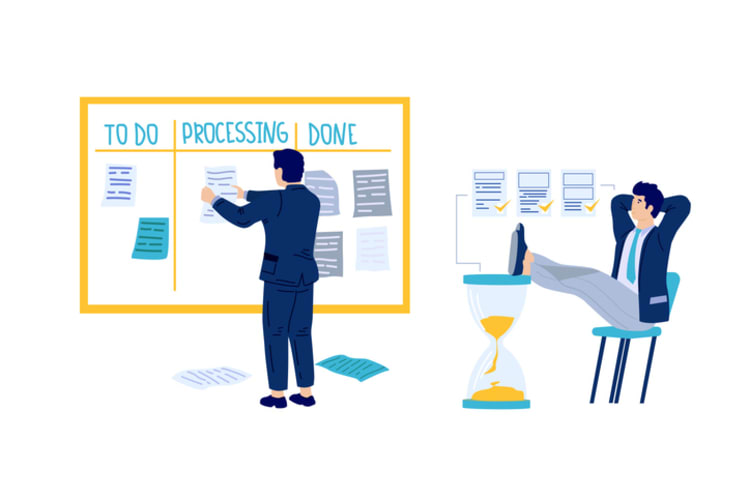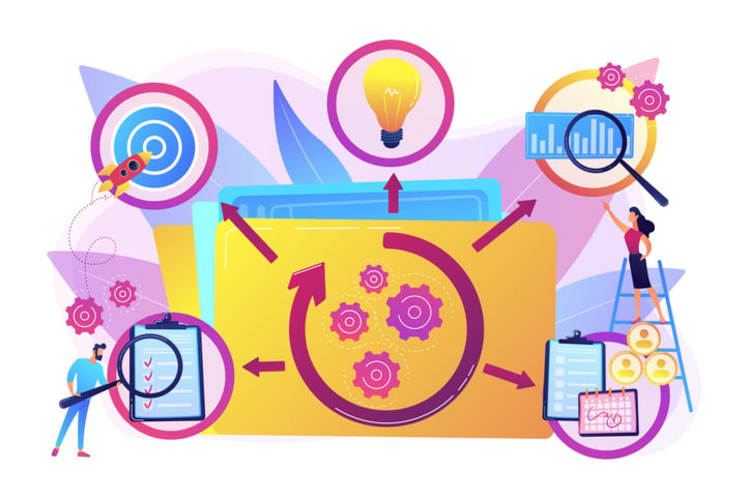Project management has become one of the most critical skills for driving business success. Whether you're already working as a project manager, considering a project management certification, or just trying to understand how to run projects more effectively, you're in the right place.
The field is evolving fast, with new tools, methodologies, and best practices emerging all the time. This guide will walk you through what's working now in project management, from the frameworks top teams are using to the certifications that actually matter to employers. Let's dive in and get you equipped to deliver successful projects that make an impact.
Key takeaways
- Project management is an essential process that facilitates successful planning, execution and closure of projects.
- A project manager oversees the coordination & completion of a project within budget & scope using methodologies, tools and techniques.
- Organizations can successfully implement PM by building strong culture, selecting right software & investing in training/development.
The essence of project management

Project management, a critical process, includes the planning, execution, monitoring, and closure of projects to ensure their timely completion, adherence to budget, and achievement of desired results. But what makes project management so important? In a world where businesses are constantly juggling multiple projects, effective project management is the key to staying afloat and achieving project goals. Organizations can enhance their processes, boost communication, and deliver successful projects by sticking to a project management framework.
Understanding the essence of project management begins with recognizing the role of a project manager and the key components that make up a successful project management process. We’ll examine these vital elements in more detail.
The role of a project manager
At the heart of every successful project lies a capable project manager. Responsible for overseeing daily operations related to a specific project, a project manager acts as the central figure in the project management body. They are responsible for:
- Planning
- Organizing
- Overseeing a project
- Coordinating team members’ efforts
- Ensuring the timely completion of the project within budget and according to the desired scope.
During project execution, a project manager may need to:
- Reallocate resources
- Adjust time and scope to ensure the team is working efficiently based on the project plan
- Identify and address any risks
- Resolve any issues that arise
- Incorporate any changes that occur
The primary project management roles are distinct and dependent on the selected project management technique, which is crucial for delivering successful projects.
Key components of project management
Project management encompasses a wide range of methodologies, tools, techniques, and best practices that help teams achieve project goals efficiently and effectively. Foundational methodologies commonly used in project management include:
- Waterfall
- Agile
- Scrum
- Kanban
With a grasp of the strengths and weaknesses of each methodology, project managers can choose the approach that best meets their specific project needs.
In addition to methodologies, there are several foundational tools and techniques that project managers can leverage to ensure the success of their projects. These include the critical path method (CPM), work breakdown structure (WBS), and program evaluation and review technique (PERT). Project managers can establish clear goals, create a timeline, manage resources, and evaluate risks for successful project management by utilizing these tools and techniques.
Popular project management methodologies

Not all projects are created equal, and that's exactly why different project management methodologies exist. What works for one team or project might completely fall flat for another, so understanding your options is crucial, whether you're a seasoned project manager or just getting started in project management.
Here are the most popular approaches teams are using today:
- Waterfall
- Agile
- Scrum
- Kanban
Each methodology brings a different philosophy to how you plan, execute, and deliver projects throughout their lifecycle. If you're pursuing a project management certification, you'll definitely encounter these frameworks. But beyond just knowing the terminology, understanding when and why to use each approach is what separates good project managers from great ones.
The right methodology helps your team adapt their working style to fit the project's specific needs, leading to smoother workflows, better communication, and ultimately, successful project delivery. Let's break down what makes each approach unique so you can choose the best fit for your next project.
Waterfall
The Waterfall methodology is a linear approach to project management, whereby each phase of the project is completed before progressing to the subsequent one. This methodology emphasizes thorough planning by breaking down and scheduling the entire project from start to finish with minimal room for iteration. Waterfall offers to-do lists, message boards, and project scheduling, making it a straightforward and cost-effective approach for certain types of projects.
However, the Waterfall methodology could potentially lack complex features for multi-functional cooperation and offer limited perspectives on work. This linear approach stands in contrast to other project management methodologies such as Agile, Scrum, and Kanban, which are more iterative and allow for greater flexibility.
Agile
Agile is a flexible and iterative project management approach that prioritizes adaptability, collaboration, and incremental delivery. Often used in software development projects, Agile emphasizes flexibility, cooperation, and step-by-step delivery, making it a favored structure for tech projects. Agile teams focus on delivering value in short iterations and continuously refining their processes.
Implementing an Agile approach can be challenging as it requires frequent, detailed updates and may not be easily scalable beyond small team environments. Despite this challenge, Agile has been adopted across a range of projects, including marketing, product development, and operations, proving its versatility and effectiveness in various contexts.
Scrum
Scrum, a subset of Agile, breaks projects into shorter sprints, enabling teams to quickly adapt to changing demands and deliver results. As a widely used approach to implementing Agile project management, Scrum involves breaking down larger projects into shorter sprints, fostering a sense of urgency and adaptability within the team.
Utilizing Scrum provides teams with the capability to:
- Adjust to fluctuating demands
- Deliver results in a timely manner
- Promote teamwork, accountability, and iterative progress towards a clearly-defined goal
Scrum is a popular choice for teams working on complex projects with tight deadlines.
Kanban
Kanban is a visual project management methodology that focuses on continuous improvement, workflow visualization, and efficient task management. A Kanban project management board is a tool that divides work into distinct stages, allowing tasks to be tracked and monitored as the project progresses.
Kanban project management is an effective way to manage projects that demand continuous flow of tasks. It allows you to:
- Optimize your work processes
- Manage unpredictable workloads
- Facilitate ongoing adaptation
- Monitor tasks and react to alterations promptly
- Recognize and address bottlenecks
Kanban boards are especially beneficial for teams that receive numerous incoming requests, such as IT teams, as they enable teams to efficiently manage and prioritize tasks.
Essential project management tools and techniques

To effectively plan, execute, and monitor projects, project managers need to employ a variety of essential project management tools and techniques. These tools and techniques help teams stay organized, on track, and accountable throughout the project lifecycle. This section delves into four essential project management tools and techniques:
- Gantt charts
- Kanban boards
- Resource management
- Risk assessment and mitigation
Understanding and leveraging these tools and techniques is crucial for project managers and team members alike, as they can greatly improve the efficiency and effectiveness of project management processes.
Gantt charts
Gantt charts are visual tools used for project planning, scheduling, and tracking, helping teams manage tasks and resources efficiently. These charts illustrate a project schedule, depicting the start and completion dates of the project’s individual tasks. Gantt charts are utilized for project planning, project scheduling, task management, and resource management, making them an essential tool for project managers and team members.
Gantt charts, with their clear visual representation of project timelines, enable teams to identify potential bottlenecks, track progress, and make necessary adjustments, thereby ensuring project success. This level of transparency and organization is invaluable in ensuring that projects stay on track and within budget.
Kanban boards
Kanban boards are visual task management tools that help teams collaborate, prioritize tasks, and monitor progress. These boards facilitate project managers and team members in visualizing tasks and their respective stages, allowing for greater transparency and accountability within the team.
Using Kanban boards has several benefits, including:
- Enhanced team collaboration
- Task prioritization
- Progress monitoring
- Reducing bottlenecks
- Enhancing communication
- Increasing visibility into the advancement of a project
By implementing Kanban boards, project managers can ensure that their teams are working efficiently and effectively towards project success.
Resource management
Resource management involves:
- Planning
- Allocating
- Managing resources such as personnel, equipment, and materials
- Maximizing project efficiency
This process is crucial for ensuring that projects are accomplished within the designated timeframe and budget. Resource management entails pre-planning, scheduling, forecasting, and optimizing the resource lifecycle for successful project delivery.
Effective resource management allows project managers to optimize efficiency through informed decisions on budget, time, and team capacity allocation. This level of organization and foresight is crucial for ensuring that projects stay on track and meet their objectives.
Risk assessment and mitigation
Risk assessment and mitigation involve identifying potential risks, evaluating their impact, and implementing strategies to minimize or eliminate their effects on project success. When executing a project, it is essential for the project manager to identify and mitigate any potential risks, such as budget overruns, missed deadlines, scope creep, and resource constraints.
The significance of risk identification and mitigation during project execution cannot be overstated. Proactive risk management allows project managers to keep their projects on track, within budget, and ultimately achieve the desired results.
Enhancing project management productivity with Kumospace
Kumospace, an innovative virtual workspace, offers a unique approach to enhancing productivity in project management. By mimicking a physical office environment, it provides a more intuitive and engaging way for teams to interact and collaborate. Its spatial audio technology allows team members to move around in a virtual space, engaging in spontaneous conversations just like in a real office, fostering a sense of camaraderie and teamwork. This feature is particularly useful for brainstorming sessions and quick, impromptu meetings, which are crucial for the dynamic nature of project management.
Furthermore, Kumospace's integration with popular project management tools ensures that all resources and updates are easily accessible, streamlining workflow and reducing the time spent on searching for information. The platform's interactive elements, such as the ability to share screens and collaborate in real-time, promote a more cohesive and productive team environment. By reducing the barriers of remote work, Kumospace effectively bridges the gap between virtual and physical collaboration, making it an invaluable asset in the realm of project management.
Successfully implementing project management in your organization

Successfully implementing project management in your organization requires building a strong project management culture, selecting the right software, and investing in training and development. By focusing on these key areas, organizations can improve their project management processes and drive project success.
We will delve deeper into each of these critical components and discuss how organizations can effectively implement project management practices to achieve their goals.
Building a strong project management culture
Building a strong project management culture involves promoting transparency, ownership, and effective communication among team members. By fostering a culture of cooperation, communication, and responsibility, organizations can ensure that projects are completed in a timely manner and within budget.
Encouraging transparency in project management fosters mutual dependence among project team members and leaders to address issues or take responsibility for their work, regardless of the project progress, plan’s complexity, or pressure.
Fostering ownership in project management is essential as it motivates team members to take ownership of their work and to be answerable for their decisions, ultimately guaranteeing that tasks are accomplished promptly and to the utmost quality.
Selecting the right project management software
Selecting the right project management software involves evaluating features, integrations, and pricing to find a solution that meets your organization’s needs. Choosing suitable project management software enables organizations to streamline processes, improve communication, and gain visibility into project development, thereby reducing costs and enhancing efficiency.
When assessing project management software, it is important to consider the following factors:
- The size and scalability of your organization
- The usability of the software
- Any challenges you wish to address
- Integration capabilities
- Your budget
- The essential features for your team
- Who will be using the software
By carefully evaluating these factors, organizations can select the best project management software to suit their unique needs and requirements.
Training and development
Training and development are crucial for ensuring that project managers and team members have the necessary skills and knowledge to effectively manage projects. Investment in training and development is vital for successful project management implementation, ensuring that team members possess the necessary skills and comprehension to execute projects efficiently.
By creating a culture of ongoing learning and advancement, organizations can ensure that their project management professionals stay up-to-date with the latest industry trends and technologies. This focus on continuous improvement and skill development can ultimately lead to increased productivity, efficiency, and project success for a Project Management Professional.
Summary
At the end of the day, strong project management skills have become non-negotiable in today's business world. Whether you're working toward a project management certification or you're already leading teams as a project manager, understanding the methodologies, tools, and techniques we've covered gives you a solid foundation for delivering successful projects.
As you move forward in your project management journey, keep these priorities front and center: build a culture where good project management practices are valued, choose software that actually fits how your team works, and invest in ongoing training and development. These are what separate organizations that consistently hit their goals from those that struggle.
Frequently asked questions
The five basics of project management include project initiation, planning, execution, monitoring and control, and closing. At each stage, business leaders should address questions, set objectives and goals, communicate roles and expectations, monitor progress, and identify and resolve roadblocks to ensure successful completion of the project.
Project management involves planning, organizing, and managing the completion of a project, while ensuring expected results are delivered on time, on budget, and within scope. This includes identifying project goals, needs, and scope, monitoring tasks, documenting progress, securing necessary resources, and leading project teams to ensure successful completion.
Outstanding project management capabilities and the capacity to effectively communicate with stakeholders and the project team. To become a professional project manager, one must develop their project management skills and obtain a certification.
Project Management is a well paid profession, with salaries ranging between $61,000 and $194,500 per year, depending on factors like education, location of the job, team size, PMP certification, and area of specialization. On average, Project Managers earn around $94,774 per year.
Project management is the process of leading a team to complete deliverables within a set timeframe using specific skills and tools.
Project management capabilities can be categorized into two main types: hard capabilities, such as technical and operational skills, and soft capabilities, which are centered around interpersonal relationships and team collaboration.





